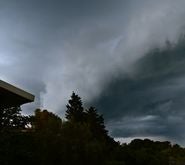From tropical volcanoes to Arctic sea-ice, recent research has discovered a variety of sources of predictability for European winter wind climate. Based on this research, what are the indicators for winter storm damage this season?
The most notable forcings of winds this winter – the solar cycle and the Arctic sea-ice extents – are forcing in opposite directions. We are unsure which forcing will dominate, and the varying amplitude of these drivers over time confuses the situation further: the current solar cycle is much weaker than the past few, and big reductions in sea-ice extent have occurred over the past 20 or so years.
There are two additional sources of uncertainty, which further undermine predictive skill. First, researchers examine strength of time-mean westerly winds over 3-4 months, whereas storm damage is usually caused by a few, rare days of very strong wind. Second, storms are a chaotic weather process – a chance clash of very cold and warm air – which may happen even when climate drivers of storm activity suggest otherwise.
RMS has performed some preliminary research using storm damages, rather than time-mean westerlies, and we obtain a different picture for East Pacific El Niños. Most of them have elevated storm damage in the earlier half of the storm season (before mid-January) and less later on. Of special note are the two storms Lower Saxony in November 1972 and 87J in October 1987: the biggest autumn storms in the past few decades happened during East Pacific El Niños. The possibility that East Pacific El Niños alter the seasonality of storms, and perhaps raise the chances of very severe autumn storms, highlights potential gaps in our knowledge that compromise predictions.
We have progressed to the stage that reliable, informative forecasts could be issued on some occasions. For instance, large parts of Europe would be advised to prepare for more storm claims in the second winter after an explosive, sulphur-rich, tropical volcano. Especially if a Central Pacific La Niña is occurring [vi] and we are near the solar cycle peak.
However, the storm drivers this coming winter have mixed signals and we dare not issue a forecast. It will be interesting to see if there is more damage before rather than after mid-January, and whatever the outcome, we will have one more data point to improve forecasts of winter storm damage in the future.
Given the uncertainty in windstorm activity levels, any sophisticated catastrophe model should give the user the possibility of exploring different views around storm variability, such as the updated RMS Europe Windstorm Model, released in April this year.
[i] Fischer, E. et al. “European Climate Response to Tropical Volcanic Eruptions over the Last Half Millennium.” Geophys. Res. Lett. Geophysical Research Letters, 2007, .
[ii] Brugnara, Y., et al. “Influence of the Sunspot Cycle on the Northern Hemisphere Wintertime Circulation from Long Upper-air Data Sets.” Atmospheric Chemistry and Physics Atmos. Chem. Phys., 2013.
[iii] Graf, Hans-F., and Davide Zanchettin. “Central Pacific El Niño, the “subtropical Bridge,” and Eurasian Climate.” J. Geophys. Res. Journal of Geophysical Research, 2013.
[iv] Baldwin, M. P., et al. “The Quasi-Biennial Oscillation.” Reviews of Geophysics, 2001.
[v] Budikova, Dagmar. “Role of Arctic Sea Ice in Global Atmospheric Circulation: A Review.” Global and Planetary Change, 2009.
[vi] Zhang, Wenjun, et al. “Impacts of Two Types of La Niña on the NAO during Boreal Winter.” Climate Dynamics, 2014.





